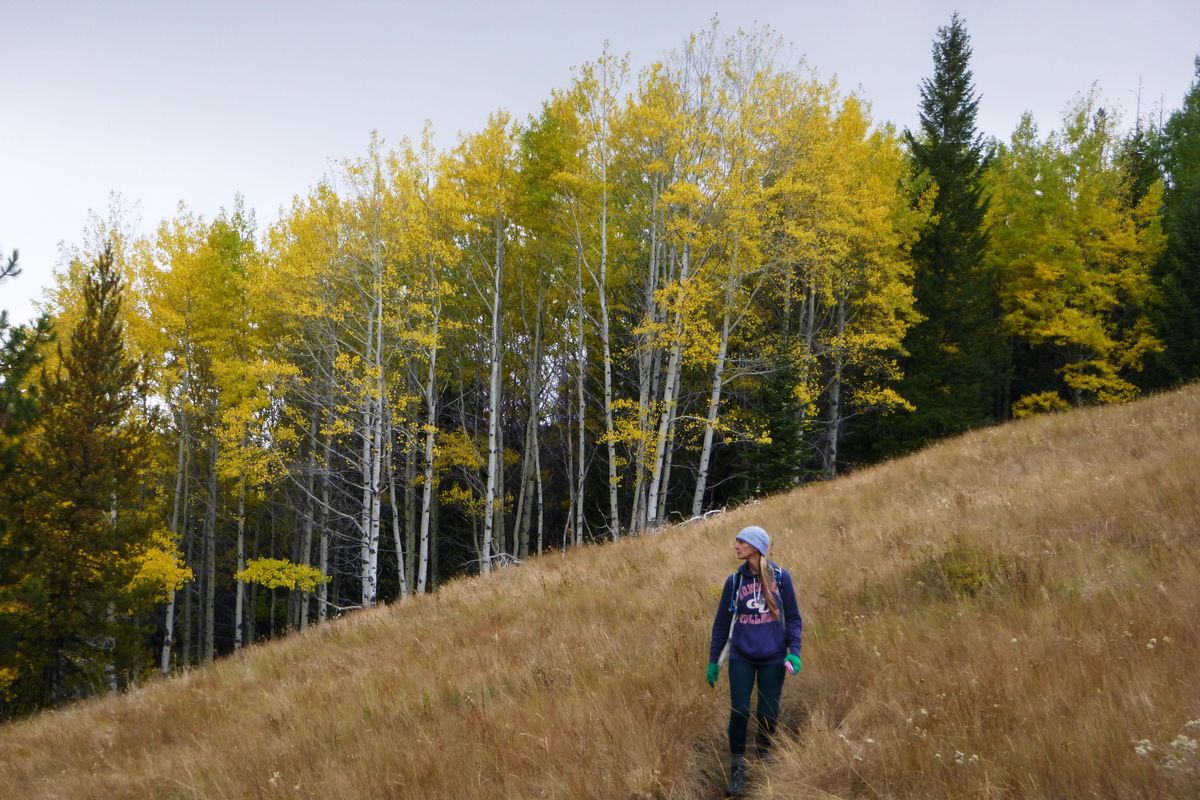Hikers fall for autumn trails

Hikers longing for a life-brightening dose of fall colors need to look no farther than the aspen grove that caught their attention as the wind rattled leaves in July, or the last huckleberry patch they grazed in August.
That green patch of purple fruit that stopped your long-distance hiking objective in its tracks will be crimson this week. You may need to slow your pace through October in Mount Spokane State Park just to feast on the autumn colors.
Autumn is one of my four favorite seasons for hiking. Fall’s fortes include no bugs and no-sweat hiking temperatures; seasonal trail maintenance is completed and landscapes of reds, oranges and yellows can brighten a fog bank.
Hiking plans and mileage must be adjusted to the fewer hours of daylight. It’s dark by 7 p.m. this week. Lights out.
And even though a fall day can offer sunny shirt-sleeve weather, temperatures plummet to freezing as the sun gets low. Snow comes and goes in this mountains this time of year, but eventually it stays.
I also look at fall hiking with some consideration for avoiding hunters who are out after big-game and forest grouse. Expect an increase in hunting pressure on the opening of the fall modern rifle deer hunting seasons – Oct. 10 in North Idaho, and Oct. 14 in Eastern Washington.
Hikers should consider wearing a fluorescent orange vest or cap this time of year. An orange vest or bandanna for your dog is a good idea, too.
And beware of moose. Always a thrill to see, moose are notoriously unpredictable – but bull moose are in the rut and more likely to be aggressive in fall.
Vegetation around Eastern Washington took a beating from sun and drought this summer leaving some lower elevation color displays crispy and less than brilliant.
But a single grove of aspen dazzled the Inland Northwest Hikers I’d joined last weekend as they descended the Jungle Hill Trail from the Kettle Crest near Sherman Pass. In a landscape of brown and green, the sunburst colors of mountain maple stopped the group for even more photos.
If you’re willing to travel, virtually any trails that gain elevation in the Okanogan-Wenatchee National Forest will feature colorful foliage this week. The North Cascades Highway offers easy access to trails, such as Blue Lake Trail 314, that quickly route hikers above 6,400 feet in elevation where they’ll find themselves shoulder-to-shoulder with yellowing alpine larch.
In the Idaho Selkirks, hikers will find huckleberry bushes ablaze and tamaracks glowing on 7,260-foot Roman Nose Mountain. A good trail system leads through the lower areas while hikers must scramble to reach the summit.
Two top local choices for an after-work hike during fall include the Liberty Creek Trail in Liberty Lake Regional Park and the Rocks of Sharon in the Iller Creek Unit of the Dishman Hills Conservation Area in Spokane Valley. Both are among a dozen good treks on the various lands protected by the Spokane County Conservation Futures Program.
Travel, timing and weather are factors in determining a favorite hike choice on a given day. But many other factors should be considered – which is why I write guidebooks – such as “Day Hiking Eastern Washington” and “100 Hikes in the Inland Northwest” – to put many options at your fingertips for making the best decision.
Following are a few other ways I sort my favorites among the hundreds of colorful autumn day hiking options in the region.
High point
Abercrombie Mountain overlooking the Pend Oreille Valley is hard to beat, especially in late October when the Western larch needles are turning yellow. Abercrombie is the second-highest mountain in Eastern Washington.
High lakes
Lone Lake or Stevens lakes south of Interstate 90 at Mullan feature quick access to mountain lakes surrounded by fall colors. Lone Lake is the loneliest of the two trailheads, which are about 100 yards apart. Lone Lake Trail climbs 2 miles with 1,600 feet elevation gain.
Larch immersion
Drive I-90 to Lookout Pass, where Western larch provide a gold rush of visuals in mid-October, and then make the most of the trip with a hike to St. Regis Lake. Better yet, head down the east side of the pass into Montana, where the larch are even thicker, and check out the hike to Hub Lake.
Local wildlife
Pine Lakes Loop at Turnbull National Wildlife Refuge winds around waters where migratory birds are pit-stopping and trumpeter swans are fledgling their young of the year. Fee for entry required, or Duck Stamp or one of the federal America the Beautiful passes.
Multiday trip
Mount Rainier or Glacier national parks simply do not disappoint as fall destinations, and hiking options abound. Any high trail in the North Cascades will provide eye candy. If you want more solitude, try the several trails in the Jumbo Pass area of the Purcell Mountains northeast of Nakusp, British Columbia, where mountain larch colors peak around Oct. 1.
Around a mountain
Sherman Peak loop off SR 20 at Sherman Pass in the Colville National Forest circumnavigates Sherman Peak in 5.3 rugged miles.
Close to home
Riverside State Park trails downstream along the Spokane River from the Bowl and Pitcher are hard to beat.
And don’t overlook a stroll along the foliage-colored paths in Finch Arboretum.